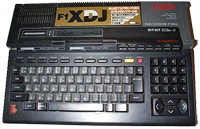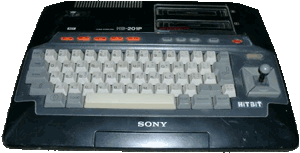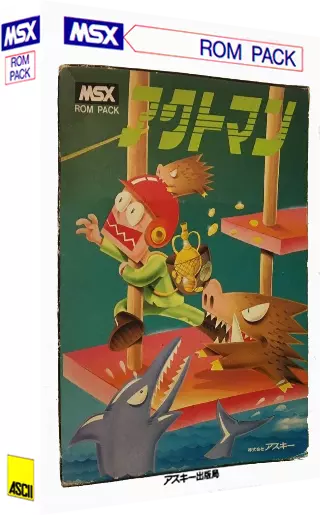Presentation
MSX was the name of a standardized home computer architecture, first announced by Microsoft on June 16, 1983, conceived by Kazuhiko Nishi, then Vice-president at Microsoft Japan and Director at ASCII Corporation. It is said that Microsoft led the project as an attempt to create unified standards among hardware makers.
Despite Microsoft's involvement, the MSX-based machines were seldom seen in the United States, but were popular mostly in Japan, the Middle East, Brazil, the Soviet Union, the Netherlands, Spain, and to a lesser extent, several other European countries. It is difficult to estimate how many MSX computers were sold worldwide, but eventually 5 million MSX-based units were sold in Japan alone.
Before the appearance and great success of Nintendo's Family Computer, MSX was the platform for which major Japanese game studios, such as Konami and Hudson Soft, produced video game titles. The Metal Gear series, for example, was originally written for MSX hardware.
History :
In the 1980s, Japan was in the midst of an economic awakening. Large Japanese electronics firms might have been successful in the early computer market had they made a concerted effort in the late 1970s. Their combined design and manufacturing power could have allowed them to produce competitive machines, but they initially ignored the home computer market and appeared hesitant to do business in a market where no industry standard existed.
Nishi proposed MSX as an attempt to create a single industry standard for home computers. Inspired by the success of VHS as a standard for video cassette recorders, many Japanese electronic manufacturers along with GoldStar, Philips and Spectravideo built and promoted MSX computers. Any piece of hardware or software with the MSX logo on it was compatible with MSX products of other manufacturers. In particular, the expansion cartridge form and function were part of the standard; any MSX expansion or game cartridge would work in any MSX computer.
Nishi's standard was built around the Spectravideo SV-328 computer. The standard consisted primarily of several off-the-shelf parts; the main CPU was a 3.58 MHz Zilog Z80, the graphics chip a Texas Instruments TMS9918 with 16 KB of dedicated VRAM, the sound and partial I/O support was provided by the AY-3-8910 chip manufactured by General Instrument (GI), and an Intel 8255 Programmable Peripheral Interface chip was used for the parallel I/O such as the keyboard. This was a choice of components that was shared by many other home computers and games consoles of the period, such as the ColecoVision home computer (an emulator was later available with which MSX systems could run some of its software), and the Sega SG-1000 video game system. To reduce overall system cost, many MSX models used a custom IC known as "MSX-Engine", which integrated glue logic, 8255 PPI, YM2149 compatible soundchip and more, sometimes even the Z80 CPU. However, almost all MSX systems used a professional keyboard instead of a chiclet keyboard, driving the price up again. Consequently, these components alongside Microsoft's MSX BASIC made the MSX a competitive, though somewhat expensive, home computer package.


On 27 June 1983, the date considered the birthday of the MSX standard, the MSX was formally announced during a press conference, and a slew of big Japanese firms declared their plans to introduce machines. The Japanese companies avoided the intensely competitive U.S. home computer market, which was in the throes of a Commodore-led price war. Only Spectravideo and Yamaha briefly marketed MSX machines in the U.S. Spectravideo's MSX enjoyed very little success, and Yamaha's CX5M model, built to interface with various types of MIDI equipment, was billed more as a digital music tool than a standard personal computer. Images of a similar model, the Yamaha CX5MII/128


During the 1980s, Europe became the largest computer games (as opposed to console games) market in the world, and the extremely popular Commodore 64, Atari 8-bit, and Sinclair ZX Spectrum computers dominated. By the time the MSX was launched in Europe, several more popular 8-bit home computers had also arrived, and it was far too late to capture the extremely crowded European 8-bit computer market.
A problem for some game software developers was that the method by which MSX-1 computers addressed their video RAM could be quite slow compared to systems that gave direct access to the video memory. This, and the fact that the completely different features the MSX-1's video chip (using the MSX Video access method) had to compensate for the slower video access were not efficiently used while porting (mostly Spectrum) software, made the MSX-1 appear slower when running ported games.
Some minor compatibility issues also plagued ported Spectrum games. For example, the Toshiba HX-10 machine was unable to read certain key combinations at the same time, preventing the Spectrum "standard" of "Q, A, O, P steering", whereas machines by other manufacturers worked fine. Later (ported) games tended to use the MSX-1 joystick port or used MSX's official arrow keys and space bar, or offered the option to choose other keys with which to control the program, solving the problem.
A larger problem was that the designers of the MSX standard bank switching protocol did not prescribe to hardware manufacturers in which banks the cartridges and, more importantly, the RAM should be found. Moreover, the MSX's BIOS did not provide this information either, thus requiring programmers to implement complex routines to "find" these resources. Often programmers assumed that the RAM and cartridges would be available at a "default" bank switch location; in reality some systems had their RAM or cartridge slot(s) not at the "default" location, but at another bank switch location. In those cases programs failed to run because they only "saw" 32 KB of the available memory, instead of the full 64 KB that almost all MSX-1 machines offered. All other mainstream MSX-1 machines offered at least the full 64 KB of RAM, with a very few exceptions, such as some early Phillips MSX-1 models (the VG8000 offered 32 KB of RAM and the VG8010, 48 KB).
MSX spawned four generations: MSX (1983); MSX2 (1986); MSX2+ (1988); and MSX TurboR (1990). The first three were 8-bit computers based on the Z80 microprocessor, while the MSX TurboR was based on an enhanced Zilog Z800 known as the R800. The MSX TurboR was introduced in 1990 but was unsuccessful due to a lack of support and the rise in popularity of the by then well-established IBM PC Compatible market. Production of the TurboR ended in 1993 when Panasonic decided to focus on release of 3DO.
The MSX3 was scheduled for market in 1990. Delays in the development of its VDP—then named V9978 on the pre-release spec sheets—caused Yamaha to miss its time to market deadline. In its place, an improved MSX2+ was released as the MSX Turbo-R; features of the new R800 processor such as DMA and 24-bit addressing were disabled. The VDP was eventually delivered two years after its planned deadline, by which time the market had moved on. In an attempt to reduce its financial loss, Yamaha stripped nearly all V9958 compatibility and marketed the resulting V9990 E-VDP III as a video-chipset for PC VGA graphic cards, with moderate success. Sony also employed the V7040 RGB encoder chip on many other products. MSX-FAN Magazine also mentions the then-impressive power of the V9990, being able to compete with much more expensive hardware such as the Sharp X68000.
MSX never became the worldwide standard that its makers had envisioned, mainly because it never took off in the U.S. and the UK. However, in Japan, South Korea, Argentina, and Brazil, MSX was the paramount home computer system of the 1980s. It was also quite popular in continental Europe, especially in the Netherlands and Spain. Classrooms full of networked Yamaha MSX were used for teaching informatics in school in some Arab countries, the Soviet Union, and Cuba, where they were wildly popular in all government education schools and centers.
As the Cuban government made a move to modernize their studies of computer systems, in 1985, Higher Pedagogical Institutes and some schools of Pre-University Education were supplied with Toshiba and Panasonic MSX systems with resident MSX Basic language, popularly known as "Intelligent keyboards". Once they proved useful, the Minister of Education continued the process installing similar systems throughout all Secondary (Junior High) centers and finalized it in Elementary schools, adult education institutions and newly nationwide formed “Computer and Electronic Youth Clubs” in 1987. Forming the Computer Clubs allowed the Cuban government to interest and educate the common citizen in computer subjects, since selling these systems, or any other personal private computer, to public was banned. (see: Censorship in Cuba )
In the 1980s, Sakhr (صخر) Computers (Developed by Al Alamiah, a Kuwaiti company), started the production of the first Arabic version of MSX computers. They started producing a Yamaha AX100 and a few other models, including MSX2 and MSX2+. The most popular and affordable model within Arab countries of the Persian Gulf was the Sakhr MSX AX170. They were also the first to Arabize BASIC and the MSX LOGO.
Al-Alamiah produced other common models, including AX100, AX123, AX150, AX170, AH200, AX200, AX230, AX235, AX250, AX330, AX350-I, AX350-II, AX355, AX370, AX500, AX550, AX660, and AX990. The only MSX console with a family computer game inlet in the MSX computer is AX330. The user can switch between MSX and family computer modes by pressing a button on the back of the computer. The other MSX computer variants, which are compatible with Sega Mega Drive and MSX games, are MSX AX660 and AX990.
Many MSX computers were used during the 1980s in Eastern European (former Eastern Bloc) countries as a tool for subtitling pirated films on VHS, or Betamax cassettes. The MSX computers were used for their simplicity and ability to display prepared titles in real time as superimposed text on mastering tapes.
The MSX arrived in Argentina in late 1984. The most popular model was the Talent MSX DPC-200, based on the Daewoo MSX DPC-200. Other models were the Spectravideo (SVI) 728 and the SVI X´Press, with a 3.5" built-in drive. Later on came the Toshiba and some very few Gradiente models from Brazil. In the late 1987, Talent presented the MSX2 TPC-310 ´Turbo´ in the Argentine market. ´Turbo´ was just a cliche, not referred for MSX2+, also based on Daewoo design. The MSX was a highly successful computer in Argentina as Commodore 64, thanks to impulse educational at national level. The MSX-Logo language was used deeply in the schools. MSXII+ never entered into production in Argentina and MSX ceased in 1990.
In total, 9 million MSX computers were sold in Japan alone, making it relatively popular but still not the global standard it was intended to be. In comparison with rival 8-bit computers, the Commodore 64 sold 17 million units worldwide in its lifetime, the Apple II sold 6 million units, the ZX Spectrum over 5 million units, the Atari 8-bit sold at least 4 million units, the Amstrad CPC sold 3 million units, and the Tandy TRS-80 Model 1 sold 250,000 units.
One (Sony) MSX2 machine was even launched into space on board of a Russian MIR spacecraft. One Professional broadcast video workstation based on Sony HitBit HB-F900 MSX2 computer and HBI-F900 AV creator was also very known in Japan.
Technical Specification :
1983 MSX-1 specification :
- Z80 CPU clocked 3.58 MHz
- 6kB RAM (min)
- 32kB ROM (min) with Microsoft BASIC
- 8KB RAM for MSX-BASIC program, 16 KB vidéo
- Cartridge slot (1 or 2)
- Joystick (1 or 2)
- Port magnétocassette 1200 - 2400 baud
- Centronics Port
- Input/ output Intel 8255 compatible
- General Instrument 8910 Compatible Sound (Yamaha YM 2149 for example)
- 3 channel Sound Generator
- Texas Instruments TMS 9918 video Chip compatible, 32 sprites
- Resolution : 64 x 48 / 256 x 192 with 16 colors
- text Mode : 40 x 24 / 32 x 24
- 72 key keyboard width 5 function touch, arrow, and 3 specialized touch.







.webp)

.webp)